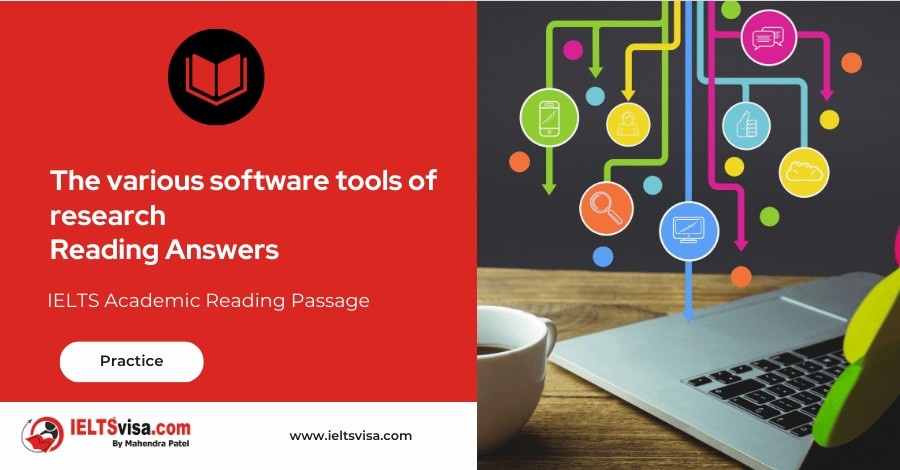The various software tools of research Reading Answers
IELTS Academic Reading Passage
A. The software tools of research are typically more abundant than hardware tools in the social sciences. The software is usually thought of as meaning computer programs that tell the hardware what to do, but any tool not related to a physical device can be considered software. Included in this category are published tests and questionnaires.
B. Often researchers want to gather information related to a general area such as personality or intelligence. For these instances, the use of a standardized test may be the best choice. With already published tests you can be sure of both validity and reliability and can save a lot of time that might otherwise be spent on test construction. Standardized tests can be classified into five main categories: achievement, aptitude, interest, personality, and intelligence.
C. Achievement tests are designed specifically to measure an individual’s previously learned knowledge or ability. They are available for many topic areas related to psychology, education, business, and other fields. Achievement tests require that prior learning take place and that this learning is demonstrated in order to pass.
D. Aptitude tests attempt to predict an individual’s performance in some activity at some point in the future. They do not require any specific prior learning although basic knowledge related to reading and writing is usually required and some preparation, such as studying up on math formulas or sentence structure, can be helpful. A well-known example of this type is the Scholastic Achievement Test (SAT), designed to predict future college performance.
E. Interest inventories also require only general knowledge but no preparation is needed. These tests look at an individual’s subjective interests in order to make predictions about some future behavior or activity. Perhaps the most used interest inventory is the Strong Interest Inventory, which compares interests related to specific careers in order to help guide an individual’s career path. Endorsed interests are compared with the interests of successful individuals in various fields and predictions are made regarding the test-taker’s fit with the various career fields.
F. Typically designed to assess and diagnose personality and mental health-related disorders, personality tests are used extensively by psychologists in clinical, educational, and business-related settings. By far the most widely used test of this type is the Minnesota Multiphasic Personality Inventory, Second Edition (MMPI-2), which compares an individual’s responses on a series of true-false items to those suffering from various mental disorders such as depression, schizophrenia, and anxiety. The theory behind the test argues that if you endorse items similar to the items endorsed by those with depression, for example, then the chances that you are also depressed increases.
G. Intelligence tests could be classified as aptitude tests since they are sometimes used to predict future performance. They could also be classified as personality tests since they can be used to diagnose disorders such as learning disabilities and mental retardation. However, because of their limited scope, we will place them in their own category. The purpose of an intelligence test is to attain a summary score or intelligence quotient (IQ) of an individual’s intellectual ability. Scores are compared to each other and can be broken down into different subcategories depending on the intelligence test used. The most commonly used tests of this type are the Wechsler Scales, including the Wechsler Adult Intelligence Scale (WAIS), the Wechsler Intelligence Scale for Children (WISC), and the Wechsler Preschool and Primary Scale of Intelligence (WPPSI).
H. Self-response questionnaires are a great way to gather large amounts of information in a relatively short amount of time. A questionnaire, similar to a survey you might see on a web page, allows subjects to respond to questions, rate responses, or offer opinions. Their responses can then be used to place them in specific categories or groups or can be compared to other subjects for data analysis. A concern with self-report, however, is the accuracy of the responses. Unlike direct observation, there is no way of knowing if the subject has told the truth or whether or not the question was understood as intended. There are several different methods for gathering information on a questionnaire or survey, including a Likert scale, the Thurstone technique, and the semantic differential. The Likert scale is a popular method used in surveys because it allows the researcher to quantify opinion based items. Questions are typically grouped together and rated or responded to based on a five-point scale. This scale typically ranges in order from one extreme to the other, such as (1) very interested; (2) somewhat interested; (3) unsure; (4) not very interested; and (5) not interested at all. Items that might be rated with this scale representing the subject’s level of interest could include a list of careers or academic majors, for example.
Questions 1-6
Reading Passage has eight paragraphs A-H. Choose the correct heading for paragraphs B and D-H from the list of headings below. Write the correct number, i-xi, in boxes 1-6 on your answer sheet.
List of Headings
i. Testing acquired knowledge
ii. The way future performance is forecast through testing
iii. The Minnesota Multiphasic Personality Inventory
iv. Software tools in research explained
v. The use of a five-point scale in testing
vi. A test used to obtain a summary score of an individual’s intelligence
vii. The method most widely used by psychologists in various situations
viii. Subjective interests employed to predict future behavior
ix. The different classes of standardized tests
x. The importance of prior learning in tests
xi. Information gathered by self-reporting
1. Paragraph B
2. Paragraph D
3. Paragraph E
4. Paragraph F
5. Paragraph G
6. Paragraph H
Questions 7-10
Choose the correct letter A, B, C or D. Write your answers in boxes 20-23 on your answer sheet.
7 Tests that are already on the market
A. need some form of reconstruction.
B. fail to ensure validity and reliability.
C. guarantee validity and reliability.
D. waste large amounts of time.
8 Some knowledge of reading and writing
A. is commonly not necessary for aptitude tests.
B. is normally a requirement in aptitude tests.
C. is less important in aptitude tests than other tests.
D. is as important as prior learning in aptitude tests.
9 With interest inventories, subjective interests are examined to
A. test people’s general knowledge.
B. help people change their career.
C. compare individual’s backgrounds.
D. forecast future behavior or activity.
10 Intelligence tests could come under aptitude tests
A. because they can be used to forecast future performance.
B. since they are not used very widely.
C. as they can be broken down into different sub-groups.
D. because they are sometimes used to diagnose learning disabilities.
Questions 11-13
Do the following statements agree with the claims of the writer in Reading Passage?
YES if the statement reflects the claims of the writer
No, if the statement contradicts the claims of the writer
NOT GIVEN if it is impossible to say what the writer thinks of this
11. The Wechsler Scales are the only type of intelligence test now used.
12. Where large quantities of data need to be collected fairly quickly self-response questionnaires work well.
13. The Likert Scale ensures greater accuracy than other techniques.
Question 14
Choose the correct letter A, B, C or D.
14 Which of the following is the most suitable heading for Reading Passage
A. Different types of intelligence test
B. How personality can be tested
C. The importance of aptitude tests
D. The various software tools of research

Solution For: The various software tools of research
Reading Answers
| 1.Answer: ix | 8. Answer: B |
| 2. Answer: ii | 9. Answer: D |
| 3. Answer: viii | 10. Answer: A |
| 4. Answer: vii | 11. Answer: No |
| 5. Answer: vi | 12. Answer: Yes |
| 6. Answer: xi | 13. Answer: Not given |
| 7. Answer: C | 14. Answer: D |
Review and Practice
- Regularly practice with IELTS reading samples and time yourself to get used to the pressure of the exam.
- Review your mistakes to understand where you went wrong and how to avoid similar errors in the future.
Our Books
Master IELTS Speaking Part 1
IELTS Writing Task 1 Book
IELTS Writing Task 2 Book
The various software tools of research Reading Answers Explanation
Comin Soon
Practice IELTS Other Modules
IELTS Listening
The IELTS Listening test assesses how well you can understand spoken English in various contexts. It lasts about 30 minutes and is divided into four sections with a total of 40 questions. The listening tasks become increasingly difficult as the test progresses.
IELTS Academic Reading
The IELTS Academic Reading section assesses your ability to understand and interpret a variety of texts in academic settings. It is designed to evaluate a range of reading skills, including skimming for gist, reading for main ideas, reading for detail, understanding inferences, and recognizing a writer's opinions and arguments.
IELTS Speaking
The IELTS Speaking test assesses your ability to communicate in English on everyday topics. It lasts 11-14 minutes and consists of three parts: introduction, cue card, and a discussion based on the cue card topic.
IELTS General Reading
IELTS General Reading tests your ability to understand and interpret various types of texts. Here are some key areas and types of content you can expect to encounter in the reading section, along with tips for effective preparation.
IELTS Academic Writing Task 1
In IELTS Academic Writing Task 1, you are presented with a visual representation of information, such as graphs, charts, tables, or diagrams, and you are required to summarize, compare, or explain the data in your own words.
IELTS General Writing Task 1
In IELTS General Writing Task 1, you are required to write a letter based on a given situation. The letter can be formal, semi-formal, or informal, depending on the prompt. Here’s a breakdown of the key components to include in your letter
IELTS Academic Writing Task 2
In IELTS Academic Writing Task 2, you are required to write an essay in response to a question or topic. Here’s a guide to help you understand the essential elements of this task
IELTS Exam Tips
To succeed in the IELTS exam, practice regularly, familiarize yourself with the test format, improve your vocabulary, develop time management skills, and take mock tests to build confidence.
Grammer for IELTS
Grammar is the foundation of effective communication in English. Understanding tense usage, subject-verb agreement, and sentence structure enhances clarity and coherence in writing and speaking.
Vocabulary for IELTS
Vocabulary plays a crucial role in the IELTS (International English Language Testing System) exam, especially in the Speaking and Writing sections. Here’s an overview of why vocabulary is important and how it impacts your performance
RECENT IELTS SAMPLES QUESTIONS AND ANSWERS
Walking with dinosaurs
Peter L. Falkingham and his colleagues at Manchester University are developing techniques that...
Money as the Unit of Amount Reading Answers
The most difficult aspect of money to understand is its function as a unit of account. In...
WEATHERING IN THE DESERT
In the deserts, as elsewhere, rocks at the earth's surface are changed by weathering, which...
Nature on Display in American Zoos
The first zoo in the United States opened in Philadelphia in 1874, followed by the Cincinnati...
Can We Prevent the Poles From Melting
Such is our dependence on fossil fuels, and such is the volume of carbon dioxide we have...
Air conditioning the earth reading answers
The circulation of air in the atmosphere is activated by convection, the transference of heat...













